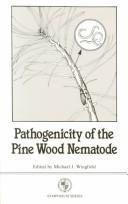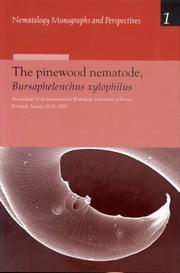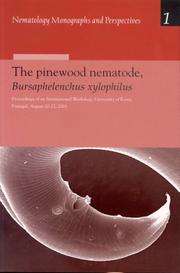| Listing 1 - 10 of 22 | << page >> |
Sort by
|
Book
Year: 1976 Publisher: Paris: AFOCEL,
Abstract | Keywords | Export | Availability | Bookmark
 Loading...
Loading...Choose an application
- Reference Manager
- EndNote
- RefWorks (Direct export to RefWorks)
Book
ISBN: 1527573931 Year: 2021 Publisher: Newcastle upon Tyne, England : Cambridge Scholars Publishing,
Abstract | Keywords | Export | Availability | Bookmark
 Loading...
Loading...Choose an application
- Reference Manager
- EndNote
- RefWorks (Direct export to RefWorks)
After devastating vast ranges of pine forests in Asian countries, Pine Wilt disease invaded European forests, becoming a worldwide threat. Originating in North America, the pathogen of this forest epidemic is a nematode, a long filamentous organism, only 1mm in length. Nematodes are carried from tree to tree by a long-horned beetle, where they lurk in its trachea and thereby spread the disease. The challenges raised for researchers to develop effective control methods were to discover how such tiny nematodes infect and kill large pine trees within a short period, and how the infection spreads repeatedly each year. Other key issues include how giant pine trees die within a short period of time due to infection by these small nematodes, how various organisms involved in this disease correlate to each other, how host trees differently respond to nematode invasion among pine species, and how environmental factors affect the progression and spread of the disease.This book is a record of the fantastic and ingenious research by many tenacious researchers who have worked to clarify these issues. Information on a wide range of fields, from molecular biology to microbiology, nematology, entomology, botany, and ecology, has been incorporated into pine wilt research. Therefore, this book will greatly stimulate the curiosity and research motivation of those interested in field biology and the conservation of the natural environment.
Pinewood nematode. --- Conifer wilt. --- Plant pathology & diseases.
Periodical
Year: 1992 Publisher: Lindenhurst, N.Y. : International Conifer Preservation Society,
Abstract | Keywords | Export | Availability | Bookmark
 Loading...
Loading...Choose an application
- Reference Manager
- EndNote
- RefWorks (Direct export to RefWorks)

ISBN: 0890540837 Year: 1987 Publisher: St. Paul (Minn.) : APS press,
Abstract | Keywords | Export | Availability | Bookmark
 Loading...
Loading...Choose an application
- Reference Manager
- EndNote
- RefWorks (Direct export to RefWorks)
Conifer wilt. --- Pine --- Pinewood nematode. --- Diseases and pests.

Abstract | Keywords | Export | Availability | Bookmark
 Loading...
Loading...Choose an application
- Reference Manager
- EndNote
- RefWorks (Direct export to RefWorks)
Conifer wilt --- Pine --- Pinewood nematode --- Diseases and pests

ISBN: 9789047413097 9789004132672 Year: 2004 Publisher: Leiden; Boston : BRILL
Abstract | Keywords | Export | Availability | Bookmark
 Loading...
Loading...Choose an application
- Reference Manager
- EndNote
- RefWorks (Direct export to RefWorks)
According to the European Plant Protection Organization, the pinewood nematode (PWN), Bursaphelenchus xylophilus is a quarantine organism at the top of the list of the pathogenic species. PWN may be found in North America (Canada, USA and Mexico) and in East Asia (Japan, Korea, China and Taiwan) and has a highly destructive capability towards conifers, in a relatively short time, causing serious economic damage in Japan, China and Korea. This nematode surveying is extremely important and a correct identification of nematode species associated with conifers is essential. Several conifers species are very susceptible (Pinus sylvestris, Pinus nigra and Pinus pinaster), the last one (maritime pine) is a particulary important economic specie in Portugal, and in southern Europe. In 1999, this nematode was found and identified for the first time in Portugal and in Europe. During 1999 and 2000, the Portuguese government, following an alert provided to European Community officials initiated an extensive national survey. During 2000 and 2001, research has been carried out regarding the morphobiometric as well as molecular (DNA: ITS-RFLP) characterization of the collected populations, as well as closely related species of Bursaphelenchus. The book details the Proceedings of an international workshop held at the University of Évora in 2001, covering all major aspects of the bioecology of the pinewood nematode (PWN), Bursaphelenchus xylophilus, its insect vectors and effects on the tree. Topics covered are: global issues and national surveys; morphology and molecular methods of identification of PWN; ecology and epidemiology; quarantine issues; tree physiology, resistance and histopathology; biology of PWN and relationships to its cerambycid vectors; control methods. General quarantine and political views are also presented.
Conifer wilt --- Pine --- Pinewood nematode --- Diseases and pests
Book
ISBN: 0114705631 Year: 1983 Publisher: London Her Majesty's stationery office
Abstract | Keywords | Export | Availability | Bookmark
 Loading...
Loading...Choose an application
- Reference Manager
- EndNote
- RefWorks (Direct export to RefWorks)
630*81 --- 674.032 --- Wood --- -Conifers --- -Timber --- -Forest production --- Building materials --- Forest products --- Lumber trade --- Forests and forestry --- Lumber --- Tree farms --- Trees --- Coniferae --- Coniferales --- Softwood trees --- Softwoods (Trees) --- Gymnosperms --- Evergreens --- Timber --- 674.032 Softwoods. Conifer timbers --- Softwoods. Conifer timbers --- 630*81 Wood and bark. Their structure and properties --- Wood and bark. Their structure and properties --- Handbooks, manuals, etc --- -674.032 Softwoods. Conifer timbers --- Forest production --- Conifers --- Handbooks, manuals, etc. --- Environmental Sciences and Forestry. Forestry -- Forest Trees --- ALLW.
Book
ISBN: 9516510795 Year: 1987 Publisher: Helsinki : Society of forestry in Finland,
Abstract | Keywords | Export | Availability | Bookmark
 Loading...
Loading...Choose an application
- Reference Manager
- EndNote
- RefWorks (Direct export to RefWorks)
633.94 --- 582.475.4 --- Plants yielding turpentine and rosin. Conifer resins. Turpentine tree (terebinth). Pistacia terebinthus. Pines, larches and firs. Pinus, Larix and Abies species --- Pinoideae. Pines. Pitch pine. Pinus --- 582.475.4 Pinoideae. Pines. Pitch pine. Pinus --- 633.94 Plants yielding turpentine and rosin. Conifer resins. Turpentine tree (terebinth). Pistacia terebinthus. Pines, larches and firs. Pinus, Larix and Abies species
Book
Year: 1955 Publisher: Bruxelles : INÉAC,
Abstract | Keywords | Export | Availability | Bookmark
 Loading...
Loading...Choose an application
- Reference Manager
- EndNote
- RefWorks (Direct export to RefWorks)
633.94 --- Academic collection. --- Environmental Sciences and Forestry. Forestry -- Forest Products -- Non-wood Products --- Plants yielding turpentine and rosin. Conifer resins. Turpentine tree (terebinth). Pistacia terebinthus. Pines, larches and firs. Pinus, Larix and Abies species. Copal resin. Agathis. Copaifera.
Book
ISBN: 0792306163 9401056471 9401137048 Year: 1991 Publisher: Dordrecht : Kluwer Academic Publishers,
Abstract | Keywords | Export | Availability | Bookmark
 Loading...
Loading...Choose an application
- Reference Manager
- EndNote
- RefWorks (Direct export to RefWorks)
Pinales --- Zone tempérée --- Temperate zones --- Identification --- identification --- Variété --- Varieties --- Nomenclature --- nomenclature --- Arbre forestier --- forest trees --- Plante ornementale ligneuse --- Ornamental woody plants --- Conifers --- -Ornamental conifers --- Ornamental conifers --- -#WPLT:syst --- Coniferae --- Coniferales --- Softwood trees --- Softwoods (Trees) --- Gymnosperms --- Evergreens --- Conifers. --- Ornamental conifers. --- Varieties. --- identification. --- nomenclature. --- #WPLT:syst --- Conifer manuel
| Listing 1 - 10 of 22 | << page >> |
Sort by
|

 Search
Search Feedback
Feedback About UniCat
About UniCat  Help
Help News
News